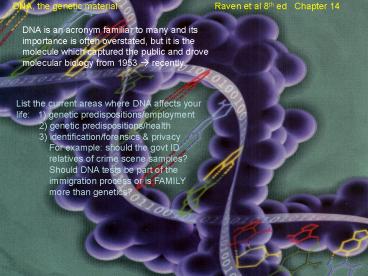DNA, the genetic material Raven et al 8th ed Chapter 14 - PowerPoint PPT Presentation
1 / 25
Title:
DNA, the genetic material Raven et al 8th ed Chapter 14
Description:
1. DNA, the genetic material Raven et al 8th ed Chapter 14 ... semiconservative model. dispersive model. 16. 17. New technique? 18. 19. Prokaryotic DNA Replication ... – PowerPoint PPT presentation
Number of Views:128
Avg rating:3.0/5.0
Title: DNA, the genetic material Raven et al 8th ed Chapter 14
1
DNA, the genetic material
Raven et al 8th ed Chapter 14
DNA is an acronym familiar to many and
its importance is often overstated, but it is
the molecule which captured the public and drove
molecular biology from 1953 ? recently.
List the current areas where DNA affects
your life 1) genetic predispositions/employment
2) genetic predispositions/health
3) identification/forensics privacy
For example should the govt ID
relatives of crime scene samples?
Should DNA tests be part of the
immigration process or is FAMILY
more than genetics?
2
Major, major points 1) Post Mendel the view
was that the particulate material of
inheritance was PROTEIN. 2)
Griffith brilliantly stumbled on the TP 3)
Avery et al showed that TP was DNA 4)
Hershey Chase proved DNA/viruses 5) Watson
Crick proposed a model 6) Meselson Stahl
showed that DNA replicated as
predictedsemiconsrvd 7) DNA as a molecule
is well known 8) repair 9)
telomeres/replication chemistry next
NOBEL(Elizabeth Blackburn) ?
3
(No Transcript)
4
The Genetic Material
- Griffiths conclusion
- information specifying virulence passed from the
dead S strain cells into the live R strain cells - IS THERE ANY EVIDENCE THAT ANYTHING PASSED TO THE
R CELLS? - Griffith called the transfer of this information
transformation - the search for the transforming principle
- began
5
The Genetic Material
- Avery, MacLeod, McCarty, 1944
- repeated Griffiths experiment using purified
cell extracts and discovered - - removal of all protein from the transforming
material did not destroy its ability to transform
R strain cells - - DNA-digesting enzymes destroyed all
transforming ability - - the transforming material is DNA
6
1940 H.F. Judson 8th Day Cr.
7
Maclyn McCarty 1970 ?
8
(No Transcript)
9
1953
Why is it called the blendor experiment? In
simple terms explain why this data is
only consistent with DNA being the genetic
material?
10
EVIDENCE FOR MODEL helix
Stolen ?
11
INTERPRETING X-RAYS
- How are x-rays used to decipher the
- structure of molecules?
12
1930 bitter
So what does this predict?
13
BASE COMPOSITION
- Howd he do that ?
- List the steps youd employ in doing a base
composition analysis.
14
Just passion, theft modelling
15
DNA Replication
- Matthew Meselson Franklin Stahl, 1958
- investigated the process of DNA replication
- considered 3 possible mechanisms
- conservative model
- semiconservative model
- dispersive model
16
(No Transcript)
17
New technique?
18
(No Transcript)
19
Prokaryotic DNA Replication
- The enzymes for DNA replication are contained
within the replisome. - The replisome consists of
- the primosome - composed of primase and helicase
- 2 DNA polymerase III molecules
- The replication fork moves in 1 direction,
synthesizing both strands simultaneously.
20
(No Transcript)
21
(No Transcript)
22
Eukaryotic DNA Replication
- telomeres repeated DNA sequence on the ends of
eukaryotic chromosomes - produced by telomerase
- telomerase contains an RNA region that is used as
a template so a DNA primer can be produced - Why is a primer needed ?
23
The enzyme which catalyzes base addng. needs a
base to make the linkage. The RNA primer provides
it, but leaves a shorter DNA after each
copy. DNADNADNADNADNA DNADNADNADNARNA
DNADNADNADNA
24
(No Transcript)
25
(No Transcript)































